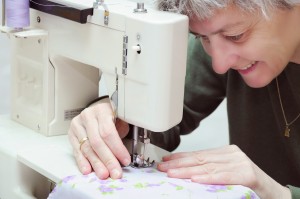 One day, you’re sewing along just fine on the old hand me down machine you received years ago from a family member. Suddenly, in the middle of your project, the machine dies. Kaput. You sigh, maybe throw out a few choice words, and – after a bowl of caramel pecan ice cream (maybe that’s just me) – decide it’s finally time for you to splurge on a new one.
One day, you’re sewing along just fine on the old hand me down machine you received years ago from a family member. Suddenly, in the middle of your project, the machine dies. Kaput. You sigh, maybe throw out a few choice words, and – after a bowl of caramel pecan ice cream (maybe that’s just me) – decide it’s finally time for you to splurge on a new one.
Many of us in that scenario would resort to the internet and check out all the shiny, new options available to us. (Because, of course, the machine will have broken down at 11pm on a Tuesday night when you can’t just go out and buy a replacement.)
Some of us would even go so far as to make a list of the models that sound appealing. Then, we head over to our local retailer the next morning and what do we find? None of the options on our list are in the store to try out. Uh-oh.
The largest sewing machine retailer in my area has a total of 30 machines in their store. Online there are over 300 different models to pick from. Chances are pretty good that what I like online isn’t going to be anywhere near me.
Not to mention the fact that some models are ONLY available online. At the same time, some models are ONLY available at a dealer. I don’t exactly understand why manufacturers do this but they do.
Let’s say you’ve found what appears to be the perfect deal on some site, you can’t find the machine locally but you want to demo it in advance. A “virtual” demo is about your only option. Here’s how to test drive a machine online.
First, a video of someone actually using the machine is the best way to get a feel for how it works.
Many of the major brands have their own channels on YouTube where they showcase their products:
- Brother: http://www.youtube.com/user/BrotherSews
- Singer: http://www.youtube.com/user/SingerSewingCompany
- Janome: http://www.youtube.com/user/JanomeUSA
- Husqvarna Viking: http://www.youtube.com/user/HusqvarnaViking
- Bernina: http://www.youtube.com/user/BerninaInternational
WARNING – once you head over to those channels, you will start drooling. Bring a bib. You’ll be mesmerized by the options. You might find three hours have passed before you remember you have other things to do.
YouTube also has many live user demos online done by real users (not those screenshot ones that don’t really show you anything at all).
Those can also be very helpful and won’t have that same “marketing” spin to them. You can do a search on YouTube for the name of the machine. However, real users don’t always know how to label their videos so they can be found. You’d be amazed at how many of these are simply called something like “my new sewing machine”.
If you can recognize the machine by sight, you can browse through those kinds of listings and see if you find the one you have in mind.
When you find a video review, here’s how you get a feel for whether or not the machine will work for you:
- Look at what the user has to do to select stitches and operate the controls. Does it look easy? Difficult?
- Get a feel for the throat space – the size of the work space between the needle and the right side of the machine. If you’re going to do quilting where you might have to sew in the middle of a large project, will the roll of excess side material fit in the throat space?
- If there’s a demonstration of the machine being threaded, does it look complicated? Do they mention how well it works or any issues with thread jamming?
- Watch how the fabric moves under the presser foot. It should move straight without too much work on the part of the user. If it looks like it’s taking a lot of effort to keep the material going straight, it might be an indication of a weak set of feed dogs. Oftentimes, very thin fabrics are used in these demos. Thick fabrics are the real test.
- Look at the stitches when the demo is done. Are they straight and even?
- Focus on the sound of the machine. Compare to videos of other machines to get a sense of the relative noise level. Not all videos are recorded the same so this might be hard to tell but you can usually get a sense of the noise accuracy based on how well you can hear the person speaking.
Now that you have a feel for its ease of use, go over a list of all the features and stitches that come with the machine.
- Read the online manual. All the major sewing manufacturers have online manuals that you can read before you own the machine. I do this for every machine that I’ve listed on this site.
- If you can’t find the list of stitches on any product descriptions, you can usually find it in the manual.
Finally, because this probably still only gets you so far down the decision making process, come back here to use the Wizard tool to compare important features about any of the ones listed on this site in a side by side table.
